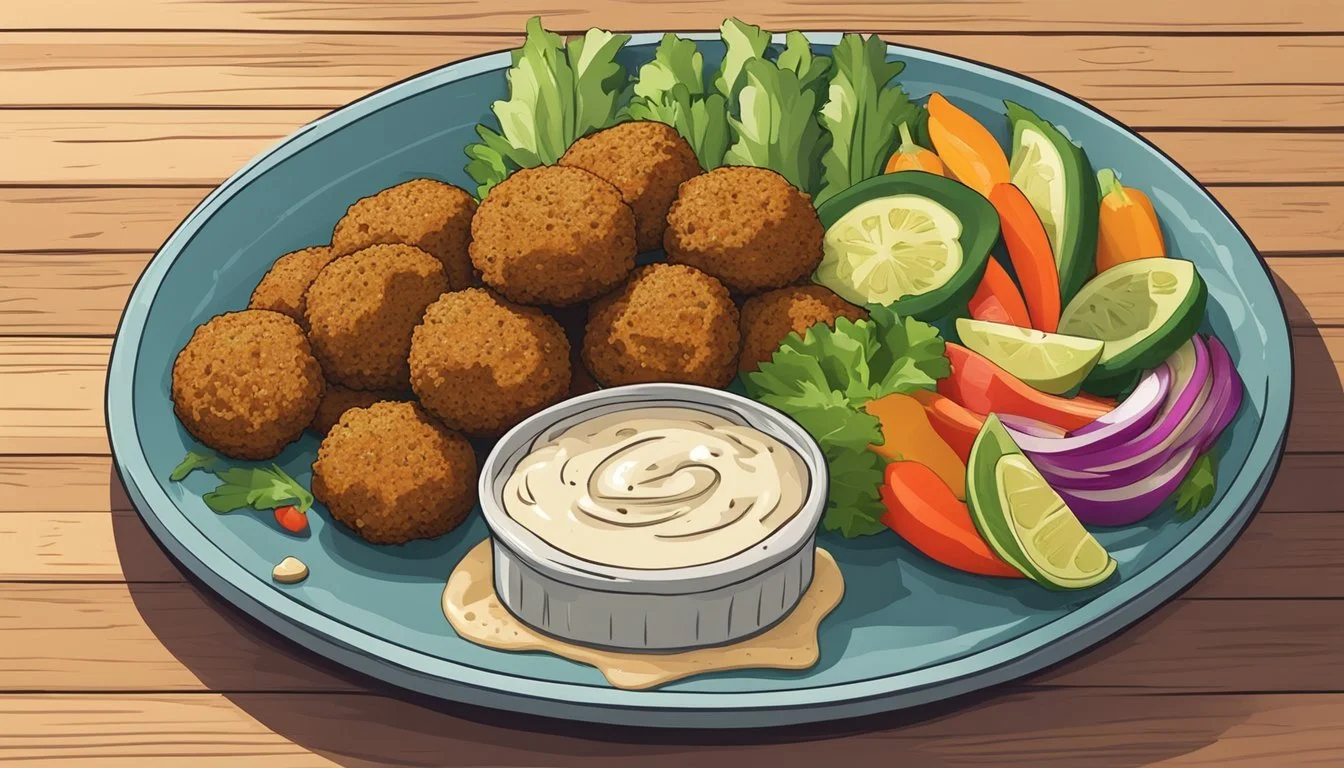How Long Does Falafel Last?
Storage Tips and Shelf Life
Falafel, a beloved Middle Eastern dish made from ground chickpeas or fava beans blended with herbs and spices, offers both a delightful flavor and a satisfying texture. When stored properly in the refrigerator, homemade falafel can last for about 3 to 4 days. This makes it a versatile and convenient option for meal prep enthusiasts looking to enjoy it over several days.
For those who purchase store-bought falafel, the shelf life may extend to a week due to preservatives and packaging. Keeping falafel refrigerated helps to maintain its freshness, flavor, and texture, allowing you to enjoy it in various dishes, from salads to wraps.
Understanding the shelf life of falafel can help in planning meals and reducing food waste. Proper storage not only preserves the unique flavors and textures of this delicious dish but also ensures it remains safe to eat.
Understanding Falafel
Falafel is a traditional Middle Eastern dish made primarily from chickpeas or fava beans. The dish is loved for its rich flavors, versatility, and nutritional benefits such as being high in protein and fiber.
Ingredients and Varieties
Falafel is made using a combination of dried chickpeas or fava beans, often mixed with onion, garlic, and a blend of fresh herbs like parsley and coriander. Key spices include cumin and coriander. Baking powder is sometimes added to help the mixture rise, creating a light texture.
There are different varieties of falafel, including those made strictly with chickpeas, those using fava beans, and a combination of both. Authentic falafel typically uses dried chickpeas soaked overnight, but some modern recipes might use canned chickpeas for convenience.
Traditional Preparation Methods
Traditional falafel preparation begins with soaking dried chickpeas or fava beans overnight. After soaking, the legumes are ground into a coarse paste combined with onion, garlic, herbs, and spices. The mixture is then shaped into balls or patties.
The falafel is traditionally deep-fried until crispy on the outside and tender on the inside. This method creates a rich, flavorful dish. Some variations might include baking or air-frying for a healthier option. Usually, falafel is served in pita bread with salad, tahini, and sometimes a hot sauce.
Storing Falafel
Proper storage methods are essential to maximize the shelf life of falafel and prevent spoilage. Considerations for short-term refrigeration or long-term freezing are crucial for maintaining freshness and quality.
Short-Term Storage
For short-term storage, falafel should be kept in the refrigerator. When freshly prepared, falafel typically lasts 3 to 5 days if stored correctly. Homemade falafel and store-bought falafel both benefit from immediate refrigeration after cooling to room temperature.
Use an airtight container or a zip-top bag to prevent moisture and bacterial growth. Ensuring the falafel is properly sealed minimizes exposure to air, which can lead to spoilage. If leftovers are noticeable by a change in odor or texture, they should be discarded to avoid foodborne illness.
Long-Term Storage
For long-term storage, freezing falafel is the preferred method. Cooked falafel can be frozen for up to 3 months if stored at 0°F (-18°C) or below. Ensure falafel is cooled completely, then place it in individual packages or use zip-top bags with labels and dates.
Packaging the falafel this way prevents bacteria and freezer burn. Whether for homemade or store-bought falafel, keeping them in an airtight container within the freezer ensures they remain fresh and safe to consume over extended periods.
Optimal Shelf Life
Understanding how long falafel remains fresh is crucial to enjoying its best taste and avoiding foodborne illnesses. Different indicators can help determine freshness, while specific spoilage signs can warn when falafel has gone bad.
Freshness Indicators
Cooked falafel should generally be stored in the refrigerator to maintain its quality. When freshly prepared and promptly refrigerated, falafel can last between 3 to 5 days. Packaging the falafel properly, like in airtight containers or wrapped securely, helps retain moisture and flavor.
Texture plays an important role in judging freshness. Falafel should maintain its crispness on the outside while remaining soft inside. If it begins to lose its firmness and becomes overly soft, it's likely nearing the end of its optimal shelf life.
Smell is another vital indicator. Fresh falafel typically has a pleasant, herby aroma. Any sour or off-putting smell suggests that the falafel is no longer fresh and should be discarded.
Spoilage Signs
Texture changes are one of the first spoilage signs. If falafel develops a slimy texture, it indicates bacterial growth. This sliminess suggests the falafel has surpassed its expiration date, signaling it should not be consumed.
Mold is a clear sign of spoilage. Any visible mold on the falafel indicates that it is unsafe to eat and should be thrown away immediately. Mold can appear in various colors, including white, green, or black.
Taste also informs spoilage. Fresh falafel tastes vibrant with distinct spices. A deteriorated taste, such as bitterness or a sour flavor, indicates that the falafel has gone bad. It is crucial to discard any falafel with an off taste to avoid potential health risks.
Regularly checking these indicators ensures that cooked falafel is safely consumed within its optimal shelf life of 3 to 5 days.
Reheating and Serving
Ensuring falafel maintains a crispy texture and delicious flavor involves choosing the right reheating method and serving it with complementary ingredients like tahini or hummus.
Best Methods for Reheating
Air Fryer: Preheat the air fryer to 350°F (180°C). Place the falafel in the basket without touching each other. Heat for 2-3 minutes, or until warmed through. Optionally, cut one open to ensure it's heated fully.
Oven: Preheat to 375°F (190°C). Arrange falafel on a baking sheet, ensuring they are not touching. Bake for 10-15 minutes, turning halfway through to ensure even heating. This method retains the crispy exterior well.
Microwave: This is the least recommended as it can make falafel soggy. Place the falafel on a microwave-safe plate, and cover with a damp paper towel. Microwave on medium power for 1-2 minutes.
Toaster Oven: Preheat to 350°F (175°C). Place falafel on the rack or a baking sheet, ensuring they're spaced out. Bake for 5-10 minutes, turning halfway to retain crispiness.
Serving Suggestions
Serve reheated falafel in a sandwich. Use pita bread or a flatbread wrap, filling it with fresh vegetables like lettuce, diced tomatoes, and cucumber.
Drizzle tahini sauce or hummus for added flavor. Adding fresh cilantro or garlic can enhance the taste.
Serve as a platter with sesame seeds, pickled vegetables, and a side of fresh salad.
Using these methods and pairings, reheated falafel can still be a delightful and satisfying meal or snack.
Prevention of Freezer Burn and Texture Loss
Ensuring falafel retains its quality during freezing and thawing involves specific techniques that minimize freezer burn and maintain texture. Adhering to proper methods helps preserve the taste and consistency of the falafel.
Proper Freezing Techniques
To prevent freezer burn and maintain texture, it is crucial to use airtight, freezer-safe bags or containers. Flash-freezing the falafel on a baking sheet lined with parchment paper before transferring it to storage helps keep each piece separate.
Ensure all air is removed from bags before sealing to avoid ice crystals. Label the bags with the freeze date to manage the freshness and to ensure you use the falafel within six months for optimal taste.
Thawing for Quality Preservation
For best results, thaw falafel in the refrigerator overnight. This slower thawing process helps retain moisture and keeps the texture intact. Avoid microwaving directly from frozen as this can lead to uneven heating and texture loss.
Reheat thawed falafel in the oven rather than frying to maintain crispiness without drying out. Place them on a baking sheet to ensure even reheating. Monitor closely to avoid overcooking and hardening.
Health and Nutrition
Falafel offers a range of health benefits and nutritional value, making it a popular choice for many.
A typical 100-gram serving of falafel contains around 333 calories. It is rich in protein, often providing about 21 grams per serving, which is beneficial for muscle repair and growth. This makes falafel a good option for those following a vegetarian or vegan diet.
The fiber content in falafel is also notable, with approximately 11 grams per 100 grams. Fiber aids in digestion and can contribute to a feeling of fullness, which may help with weight management.
Key minerals found in falafel include calcium (54 mg), magnesium (82 mg), phosphorous (192 mg), and potassium (585 mg). These minerals support various functions such as bone health, fluid regulation, and blood pressure control.
Falafel is typically flavored with a mix of spices like cumin, coriander, and garlic, and may include salt, pepper, and cayenne pepper for added taste. These spices not only enhance flavor but can also offer their own health benefits, such as anti-inflammatory properties.
In summary, falafel is a nutritious and flavorful option that fits well into vegetarian and vegan diets. Its high protein and fiber content, along with beneficial minerals, make it a healthy choice for many.







